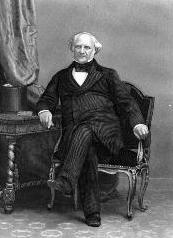A Taste for the Fine Arts - George Peabody's Gift to Maryland
- A Message from Edward Papenfuse and Matthew Lalumia
- An Introduction from the Curators
- George Peabody
- The Peabody Gallery of Art
- A Tour of the Exhibition in Government House
- Works from the Peabody Collection on exhibit in Government House

George Peabody
An Introduction from the Curators
CAROL E. BORCHERT
Curator, Maryland Commission on Artistic Property
ELIZABETH SCHAFF
Curator and Archivist, The Peabody Institute
George Peabody achieved international success as an investment banker, despite his family's modest means, few connections, and his lack of formal education. Born in Danvers, Massachusetts in 1795, Peabody began his commercial career in Baltimore but moved to London in 1837. Maryland remained, however, a focus of attention for Peabody throughout his life, and the state owes him an enormous debt of gratitude for his financial support, for his philanthropy, and for his visionary gifts to the cultural heritage of Maryland and the nation. In 1838, Peabody helped to save Maryland from financial ruin. At a time when the market was flooded with bonds, Peabody sold Maryland bonds by assuring the state's good credit and by purchasing a large quantity of the securities himself. In 1851, Peabody underwrote the American installation in the Great Exhibition, and in the years that followed he created America's first museums of natural history, archaeology and ethnology at Yale and Harvard Universities and the Peabody Museum in Salem, Massachusetts. After the devastation of the Civil War, he funded the Peabody Education Fund which established public education in the South. In London, he founded the Peabody Trust to provide housing for London's poor. The Peabody Education Fund and the Peabody Trust were the first philanthropic foundations in America and England.
George Peabody reserved one of his most extraordinary gifts
for the city of Baltimore. In 1857, he established the
Peabody Institute and its Conservatory of Music, and made
provisions for a Gallery of Art. The Peabody Conservatory
remains one of the foremost music education institutions in
the nation.
The Peabody Art Gallery was one of the first public art galleries in the nation,
and before the establishment of the Walters Art Gallery and
the Baltimore Museum of Art, it afforded Marylanders their
first opportunity to view important works of art. Through
Peabody's initial benefaction as well as the generosity of
his friends and colleagues, the Peabody Collection became
one of the richest collections of American art. It includes
the finest collection of works by Maryland sculptor William
Henry Rinehart, as well as paintings by American artists
George Bellows, Mary Cassatt, Thomas Wilmer Dewing, Asher B.
Durand, Childe Hassam, Winslow Homer, Thomas Hovenden, and
George Innes.
By the 1930s, due to mounting financial pressures and an
increasing emphasis on teaching music, the Institute decided
to close the Peabody Art Gallery. The Walters Art Gallery
and the Baltimore Museum of Art had by that time become the
premier art repositories in Maryland, and much of the
Peabody Collection was placed on loan to them, the Maryland
Historical Society, and other local institutions. In 1996,
the Peabody Collection was acquired by the state of Maryland
in order to ensure that this remarkable collection, rich in
portraits of prominent Marylanders, regional scenes and
works by Maryland artists, would be preserved in perpetuity
for the citizens of the state. As part of the State Art
Collection, the Peabody Collection is administered by the
Maryland Commission on Artistic Property of the Maryland
State Archives. Many of the works remain on loan to the
Baltimore Museum of Art, the Walters Art Gallery, the
Maryland Historical Society, and the Maryland Institute
College of Art.
George Peabody died in London on November 4, 1869. The carriage of Queen Victoria and the Prince of Wales followed the hearse to Westminster Abbey where he was the first American to be interred with full honors. Her Majesty's newest vessel, the Monarch, then carried Peabody to his final resting-place in Salem, Massachusetts. He is remembered today as the founder of modern philanthropy.
It is with great pleasure that we present the first exhibition of works from the Peabody Collection. We are particularly grateful to Frances Hughes Glendening for her support of this exhibit in Government House and for her continued support of the arts in Maryland through the Celebration of the Arts program.
|
This web site is presented for reference purposes under the doctrine of fair use. When this material is used, in whole or in part, proper citation and credit must be attributed to the Maryland State Archives. PLEASE NOTE: The site may contain material from other sources which may be under copyright. Rights assessment, and full originating source citation, is the responsibility of the user. |
© Copyright December 15, 2023 Maryland State Archives
